Skills shortages in Canada
Introduction
During October and November of 2013, the Canadian Council of Chief Executives (CCCE) surveyed its member companies on their skills needs and human resource priorities. Topics they were asked to address included:
- skills and attributes that matter most when recruiting new employees;
- fields and regions of the country where they are experiencing skills shortages;
- demographic concerns;
- a description of employer-sponsored education and training initiatives;
- partnerships with post-secondary institutions; and
- experience with the immigration system, and with the Temporary Foreign Worker Program.
More than 100 of the CCCE’s 150 member companies, representing Canada’s largest employers in all industrial sectors and regions of the country, participated in the survey – a response rate that clearly underscores the importance of these issues to corporate Canada.
In most cases, survey responses were provided by human resource vice-presidents, directors and/or managers. This brief examines the results of the survey as they relate to skills shortages. Specifically, it looks at whether CCCE members are concerned about shortages, where shortages are most persistent, in what fields workers are the most difficult to find and retain, why shortages exist and whether they have an impact on future projects and/or investments in Canada.
Are skills shortages a concern for CCCE members?
The survey results do not support the argument that Canada is suffering from a comprehensive, national skills shortage. Rather, they suggest that shortages are limited to certain regions, sectors and occupations in Canada – a conclusion consistent with the findings of recent reports by TD Economics and the Conference Board of Canada.
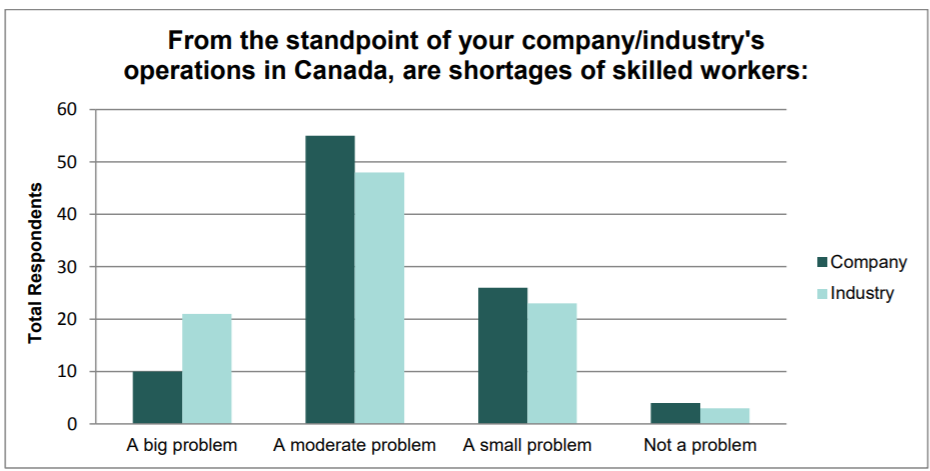
For instance, while 73 percent of respondents reported that shortages were a big or moderate concern for their industry, this concern is largely limited to certain sectors, mainly energy, utilities, mining and construction, accounting, manufacturing, retail and food services and insurance.
Similarly, while close to 40 percent of Western Canadian companies reported that shortages were a large concern for their industry, only 17 percent of Quebec and Eastern Canadian-based companies, and 11 percent of Ontario-based companies, reported comparable levels of concern.
Where are the most persistent shortages?
Collectively, responding companies reported that they were unable to fill approximately 11,000 jobs over the past two years. More than two-thirds of respondents ranked Alberta as the province most prone to shortages – double that of Ontario and Quebec combined. Saskatchewan was also mentioned often due to its tight labour market and high vacancy rates.
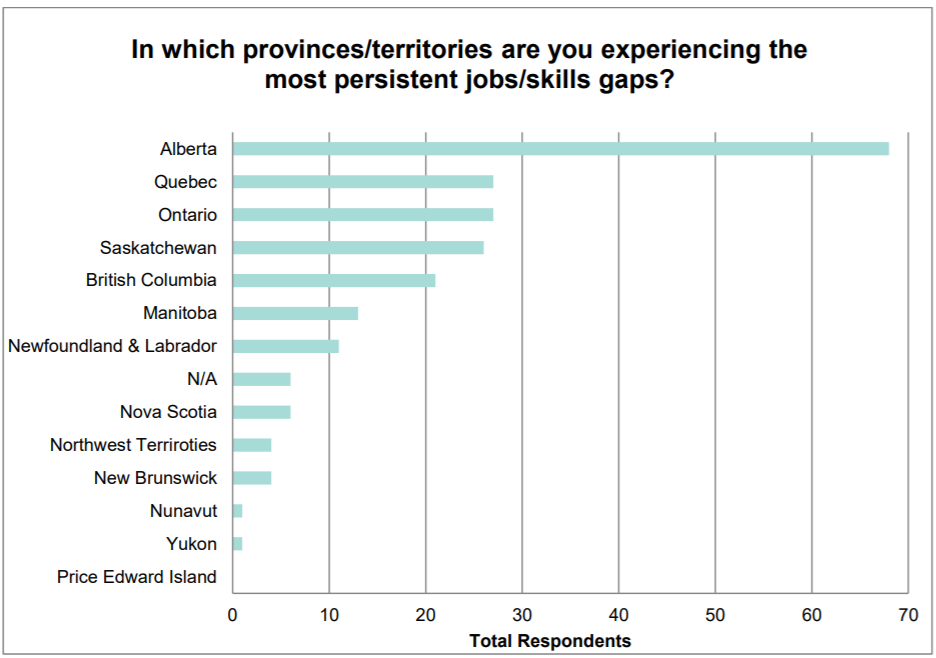
When asked in which cities, towns and rural regions shortages were most prevalent, a large majority of respondents – from nearly all sectors – reported difficulties finding people in Calgary, Edmonton, and the Wood Buffalo region of Alberta, mainly Fort McMurray. Saskatoon, Regina and various rural regions of Saskatchewan were also frequently cited, as were Red Deer, Grande Prairie, Winnipeg, Vancouver and pockets of Southern Ontario and Southwestern Quebec.
In which fields are workers most difficult to find and retain?
Engineering and related occupations, such as engineering technologists and technicians, were ranked as fields in which workers were most difficult to recruit. This was followed closely by information technology, a category that includes web developers, web specialists, network administrators, programmers and cyber-security specialists. Workers with general business skills, such as accountants, financial and investment analysts, regulatory specialists, investment dealers, securities agents, traders and analytics professionals also were cited as in significant shortage.
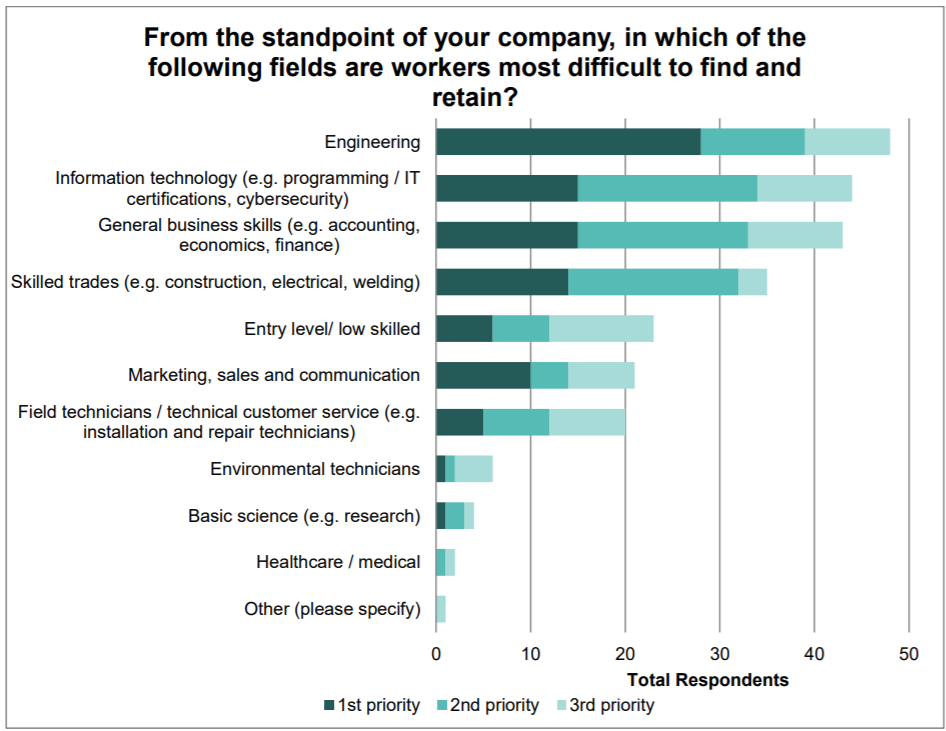
Several jobs in the insurance field (in the general business skills category) were also frequently mentioned, including underwriters, field claims managers, appraisers, claims handlers and actuaries. As one respondent put it, “Students do not go to school for insurance and many are unaware of the industry. Consequently, a highly competitive market for specialized talent has developed within the sector.”
Finally, several companies identified chronic shortages in several skilled trades, particularly qualified journey persons with Red Seal credentials. This includes a variety of occupations, such as carpenters, plumbers, mechanics, electricians, boilermakers, welders, heavy equipment operators, and machinists.
Respondents said they expect shortages in these four fields to grow over the next five to 10 years as Canada’s population ages and the economy expands. As one large employer noted, “Many of our shortages are currently moderate, but will become increasingly difficult and problematic in years to come. Therefore, we are proactively developing programs and solutions which will better support our future needs.”

Respondents also highlighted challenges related to recruiting experienced personnel, particularly at the executive, project management and senior technical levels. While this was certainly a concern, most responding companies were “somewhat confident” about their ability to replace the skills of retiring, experienced workers. Nearly all respondents emphasized their proactive planning efforts, which typically include attrition forecasting, workforce planning, succession planning, leadership training and development, and knowledge transfer.
What are the jobs needs from a regional perspective?
Respondents from Western Canada most often selected engineering and skilled trades as the fields in which workers were most difficult to find and retain, followed at a distance by information technology. In contrast, companies from Ontario chose information technology and general business skills as the fields most in need, followed by marketing, sales and communications and skilled trades.
Companies from Quebec and Eastern Canada cited similar needs for workers in the information technology, general business skills and engineering fields. A number of respondents with operations in Quebec highlighted challenges in finding bilingual workers, leading to shortages in key “person-to-person” positions, primarily in the retail and financial services sectors.
Why do these shortages exist?
A significant majority of respondents reported that the primary barrier to filling shortages was a scarcity of skilled workers in certain fields, such as managers, professionals, engineers and skilled tradespeople. Many of these companies reiterated that these shortages were acute and limited to certain regions, sectors and occupations. A few respondents suggested that these shortages exist because the education system was not producing the graduates that companies need.
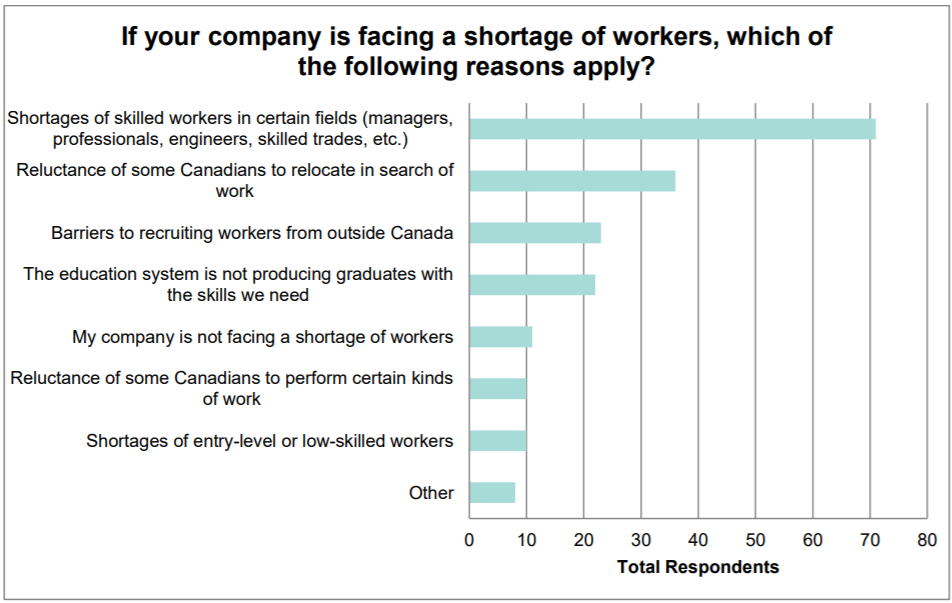
The second most reported barrier was the reluctance of some Canadians to relocate in search of employment. This is consistent with the results from a 2011 report by the Canadian Employee Relocation Council, which found that only two in 10 Canadians were willing to move to another city for work. Further complicating labour mobility in Canada are 13 different provincial credential recognition regimes and high transportation costs.
Finally, the third most reported barrier was the challenge of recruiting workers from outside of Canada. While some respondents praised recent reforms to the immigration system, others identified persistent obstacles, including delays in processing applications for temporary foreign workers, issues related to foreign credential recognition, difficulties in attracting immigrants to certain regions of the country and challenges in integrating new Canadians into the community and workplace.
Will shortages have an impact on future projects and/or investments in Canada?
Approximately two-thirds of respondents expect shortages to have a medium or large impact on future major projects and/or investments.
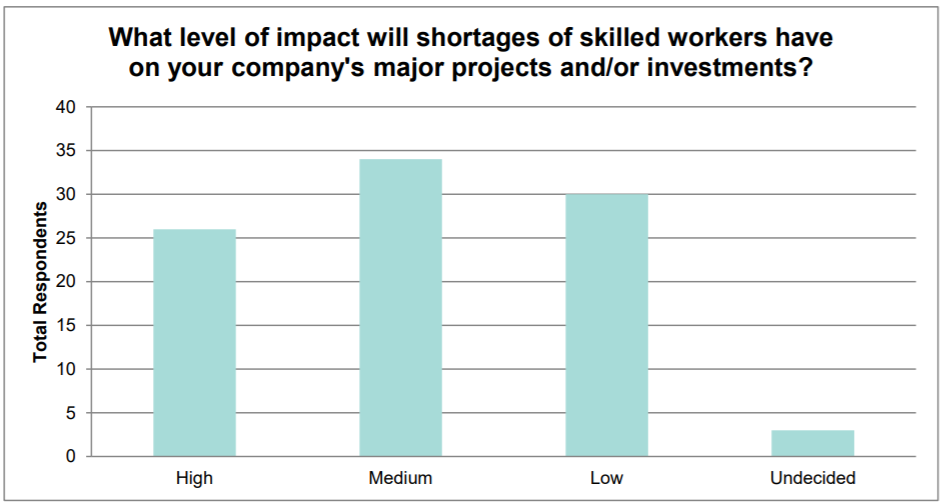
One respondent said that unfilled positions will result in a “significant productivity and efficiency loss that will greatly impact our clients and employees. Over the long-term, it will lead to reduced profitability due to inflated staffing costs and a potential loss of future business because of an inability to deliver.” Another respondent suggested that “the absence of specialized and skilled workers has, in some cases, already had a direct impact on our ability to achieve operational targets.”
A respondent from one large multinational indicated that “If we are not able to fill these positions in Canada, the work will be sent to other sites around the world.” When that happens, “it rarely comes back.”
For many companies, growing shortages have become a key corporate risk. Accordingly, they are investing resources in identifying short, medium and long-term solutions both within their companies and their respective industries. Nonetheless, most companies recognize that more needs to be done to mitigate shortages, including improving their working relationships with governments and educational institutions.












